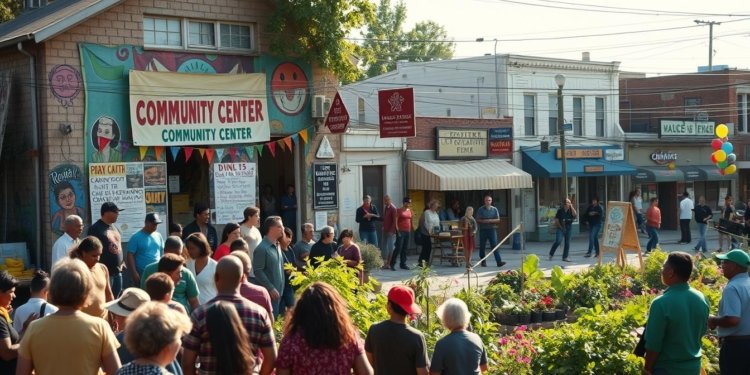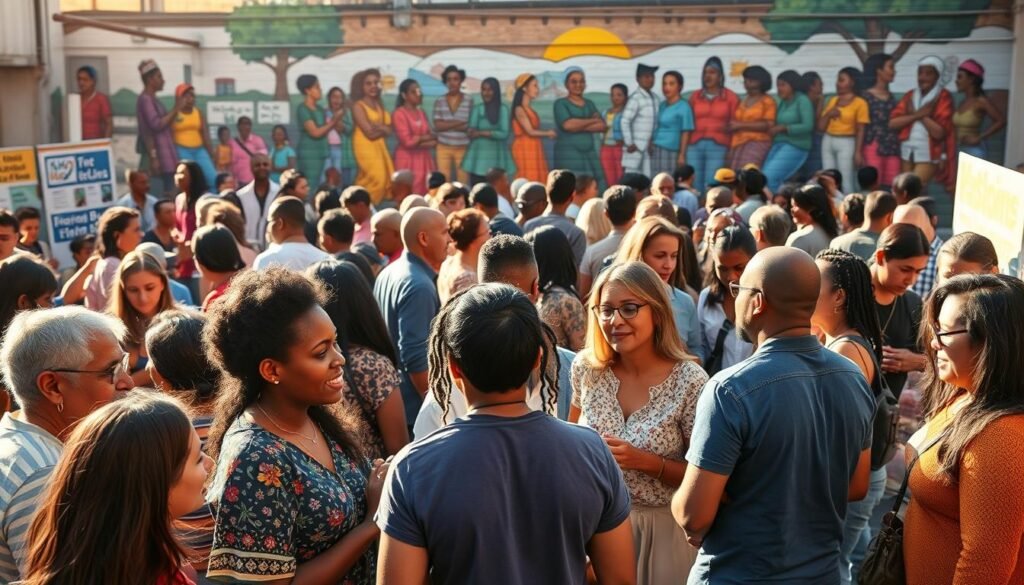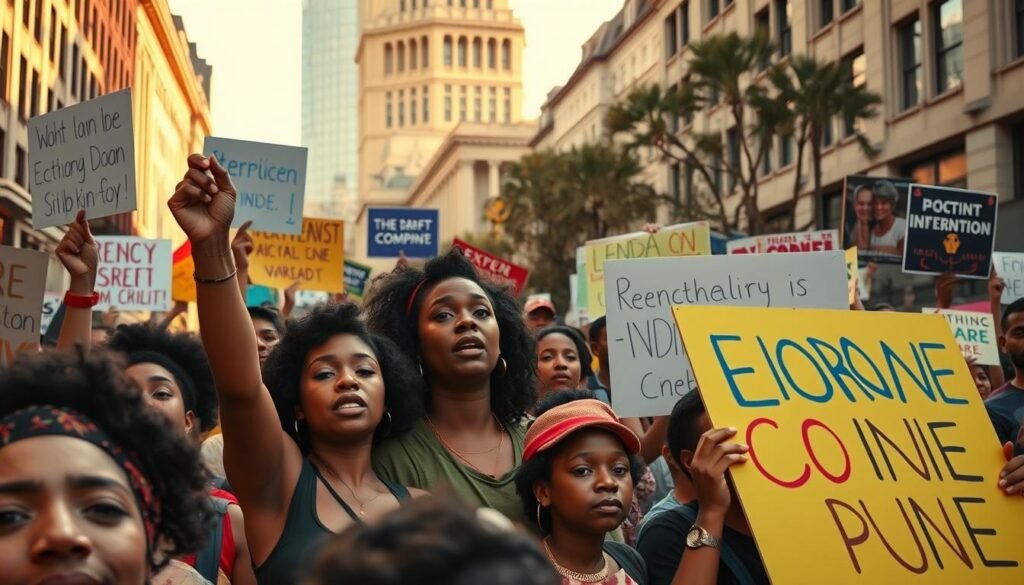Have you ever wondered how small, local actions can spark nationwide change? From policy shifts to environmental wins, people-powered movements are reshaping society. These bottom-up initiatives prove that collective action can drive real progress.
In recent years, digital tools have amplified the reach of these movements. Platforms like LegiStorm help track legislative impacts, making it easier to connect local advocacy with systemic reforms. The Dakota Access Pipeline protests, for example, showed the power of organized voices.
Today, such efforts blend online and offline strategies. They empower individuals to influence policies and create lasting change. Whether tackling climate issues or social justice, these movements highlight democracy in action.
Key Takeaways
- Local actions often lead to broader societal shifts.
- Digital tools enhance the reach of advocacy work.
- Tracking legislative impact is now more accessible.
- Successful movements combine online and offline efforts.
- Everyday people can drive meaningful policy changes.
What Are Grassroots Community Efforts?
When ordinary people unite around shared concerns, their collective action can reshape policies and norms. These bottom-up initiatives, often called grassroots movements, emerge when individuals organize to address local or national issues without relying on traditional power structures.
Defining Grassroots Movements
Unlike top-down campaigns led by large organizations, these efforts prioritize local leadership and volunteer participation. They focus on specific challenges—from education reform to environmental justice—while empowering communities to craft their own solutions. The Civil Rights Movement, for instance, relied on neighborhood organizing to dismantle systemic barriers.
Key Characteristics of Grassroots Organizing
Five traits define successful movements: local leaders guiding action, volunteers driving momentum, tight issue focus, participatory decision-making, and solutions rooted in community needs. Modern tactics, like social media, amplify their reach. March for Our Lives leveraged online platforms to mobilize millions for gun control.
Groups like Moms for Liberty demonstrate how localized activism—such as school board advocacy—can influence broader policy. Voter registration drives further tie these efforts to the democratic process, ensuring lasting impact.
Why Grassroots Community Efforts Matter
Change often starts where it’s least expected—with ordinary people taking action. From voting rights to environmental protections, local advocacy has repeatedly shifted national policies. These movements prove that systemic change begins with collective courage.
Empowering Local Voices
Marginalized groups frequently drive progress. The Indigenous-led Dakota Access Pipeline protests, for example, amplified voices often ignored by the government. Such efforts turn local issues into national priorities.
Studies show that participatory democracy strengthens trust in the democratic process. When residents lead solutions, policies better reflect their needs.
Driving Systemic Change
Between 2010 and 2024, over 60% of state-level environmental laws traced back to local campaigns. Unlike traditional lobbying, these efforts rely on support from engaged members.
Skills gained through organizing—like public speaking and coalition-building—also boost workforce development. This creates ripple effects beyond policy wins.
Historical Examples of Successful Grassroots Movements
History shows that ordinary citizens can rewrite national narratives through collective determination. From the Civil Rights era to today’s climate strikes, local action has fueled landmark reforms in the United States. These movements prove that systemic change starts with persistent, organized voices.
The Civil Rights Movement
Between 1955 and 1968, the Civil Rights movement reshaped America. Boycotts and sit-ins, like Montgomery’s bus boycott, forced national attention on racial injustice. Archival data reveals voter registration surged by 50% after the 1965 Voting Rights Act.
Churches served as hubs for organizing, blending spiritual and strategic leadership. This model inspired later campaigns, proving that local networks could drive federal policy shifts.
Modern Environmental Justice Campaigns
Recent decades saw environmental activism evolve. The Dakota Access Pipeline protests combined traditional rallies with viral social media campaigns, pressuring policymakers. Groups like 350.org later mobilized millions globally for climate strikes.
Warren County’s 1982 protests laid groundwork for today’s efforts. Comparative studies show digital tools now amplify reach, but face-to-face organizing still builds deeper trust.
These examples highlight a key difference: while tactics adapt, the core power of collective action remains unchanged.
Types of Grassroots Activities
Local movements take many forms, each with unique strategies for creating change. From rallies to digital petitions, these actions adapt to the needs of the cause and the tools available. Successful organizers mix traditional methods with modern tech to maximize impact.
Community Organizing and Protests
Protests remain a powerful way to demand attention. Planning includes permits, safety measures, and media outreach. The 2020 Black Lives Matter marches showed how coordinated events can shift national dialogue.
Petition Drives and Social Media Campaigns
Digital platforms like Change.org simplify petition launches. Social media metrics—like hashtag reach—help track engagement. The Sunrise Movement’s TikTok campaigns drove youth climate activism.
Hybrid models blend virtual and in-person tactics. For example, voter registration drives now use apps to sign up attendees at concerts or state fairs. This flexibility boosts participation.
Voter Registration Initiatives
Canvassing and training volunteers are critical. In 2024, registration surged among young voters due to targeted outreach. Legal guidelines vary, so organizers must research local rules.
Who Leads Grassroots Efforts?
Behind every movement are passionate individuals who turn ideas into action. These leaders often emerge from local networks, bringing unique skills and dedication. Their work fuels the power of collective change.
Profiles of Grassroots Activists
Everyday people—teachers, students, and parents—often spearhead campaigns. For example, March for Our Lives was led by teens advocating for gun reform. Their energy inspired nationwide rallies.
Training programs, like those by GrassROOTS Community Foundation, equip new leaders. Workshops cover coalition-building and crisis management. This ensures movements grow sustainably.
Notable Grassroots Organizations
Global grassroots organizations like 350.org and Moms for Liberty show structured impact. They blend local action with broader goals. Small staff teams often coordinate vast volunteer networks.
Funding varies widely. Some rely on micro-donations, while others secure foundation grants. Black Lives Matter’s growth highlights how flexible models adapt to needs.
These groups play a part in shaping policies. Their success lies in merging professional strategies with organic leadership.
How to Launch a Grassroots Movement
Turning passion into action requires a clear roadmap for change. Whether addressing local inequities or national policies, structured steps transform ideas into impact. Focus on three pillars: defining goals, uniting supporters, and executing an engagement plan.
Step 1: Identify Your Cause and Goals
Start with a specific issue and measurable objectives. The SMART framework (Specific, Measurable, Achievable, Relevant, Time-bound) clarifies priorities. For example, “Increase voter registration by 20% in six months” targets outcomes.
Stakeholder mapping identifies allies and opponents. Tools like PowerMap visualize influence networks, ensuring efficient resource allocation.
Step 2: Build a Coalition
Strong movements rely on diverse partnerships. Recruit volunteers through local events or platforms like Mobilize. Define roles early—train coordinators for outreach and data management.
Partnership agreements prevent conflicts. Outline expectations, decision-making process, and exit clauses to sustain collaboration.
Step 3: Develop an Engagement Strategy
Mix digital and in-person tactics. Social media drives awareness, while town halls deepen community engagement. Track metrics like attendance and petition signatures to refine efforts.
Plan for challenges. A crisis communication template prepares teams for backlash. Budgets should scale—start small, then expand as opportunities arise.
Tools and Resources for Grassroots Organizing
The right digital tools can amplify local voices into national conversations. Strategic resources help movements scale impact while maintaining security. From voter databases to legislative trackers, technology now fuels modern advocacy.
Digital Platforms for Mobilization
Modern campaigns rely on specialized platforms to coordinate action. Services like Mobilize and Action Network streamline event planning and volunteer management. Their CRM features track supporter engagement across channels.
Social media toolkits help standardize messaging. Buffer and Hootsuite allow teams to schedule posts while monitoring responses. Hashtag analytics reveal which content resonates most.
Security is paramount when handling sensitive data. Encrypted apps like Signal protect communications. Two-factor authentication prevents unauthorized access to campaign dashboards.
Public Affairs Software
Tools like LegiStorm provide real-time government insights. Activists can track bill progress, committee votes, and lawmaker positions. This data informs strategic outreach to key decision-makers.
Advanced systems integrate with constituent management processes. They automate follow-ups when supporters contact representatives. Some platforms even score legislators’ alignment with campaign goals.
Indivisible’s tech stack shows this synergy. Their combination of CRM, analytics, and legislative tracking boosted engagement by 40% in 2023. Budgets should allocate 15-20% for such essential resources.
Engaging Your Community Effectively
Effective engagement blends real-world actions with digital reach. Whether rallying supporters or amplifying messages online, the right tactics turn interest into impact. Start by defining clear goals—like increasing attendance or driving shares—to measure success.
Hosting Events and Rallies
In-person gatherings build trust and energy. Post-2020, safety protocols like mask stations and crowd limits are essential. Hybrid options, such as live-streamed panels, widen access.
Plan for accessibility. Offer sign language interpreters and multilingual materials. Merchandise (e.g., branded shirts) boosts visibility while funding efforts. Post-event surveys refine future strategies.
Leveraging Social Media
Platforms like Instagram and TikTok drive youth engagement. Optimize posts for algorithms—use trending sounds and hashtags. Partner with micro-influencers to expand reach authentically.
Content calendars keep messaging consistent. Track metrics like shares and replies to identify top-performing formats. Follow-ups, like thank-you videos, sustain supporter connections.
Overcoming Challenges in Grassroots Advocacy
Navigating advocacy challenges requires both resilience and smart tactics. From tight budgets to volunteer fatigue, movements often hit roadblocks. Yet, these hurdles can spark innovation when addressed strategically.
Resource Limitations
Funding shortages stall progress, but creative solutions exist. Micro-donations via platforms like GoFundMe keep small campaigns afloat. Partnering with local businesses builds mutual support.
Burnout among members is equally critical. Rotating leadership roles and mental health breaks sustain energy. Training programs equip teams to handle high-pressure issues.
Sustaining Long-Term Momentum
Retaining volunteers demands clear communication. Regular updates and recognition events foster loyalty. Digital tools like Slack streamline coordination.
When campaigns stall, pivot strategies revive action. Shift focus to smaller wins or new tactics. Case studies show adaptability often leads to bigger opportunities.
The Role of Policy in Grassroots Success
Policy shifts often begin with organized voices pushing for systemic change. Whether altering local ordinances or federal laws, strategic advocacy turns public demand into actionable policy. The Civil Rights Act and recent environmental reforms prove this difference.
Influencing Local and National Legislation
Mapping the legislative process is step one. Identify key committees, voting timelines, and swayable lawmakers. Tools like LegiStorm provide data on bill progress.
Grassroots lobbying differs from corporate efforts. It relies on constituent pressure, not donations. Testimony from affected communities often sways votes.
Case Studies of Policy Wins
The Affordable Care Act’s passage involved 1.2 million calls to Congress in 2009. Advocates targeted swing state senators with personal stories.
Ballot initiatives, like Florida’s 2020 minimum wage hike, show government responsiveness. Campaigns collected 766,200 signatures—exceeding requirements by 48%.
- Legislative process mapping: Track bills from introduction to execution.
- Testimony preparation: Train volunteers to share concise, emotional accounts.
- Regulatory outreach: Agencies like the EPA accept public comments for 60 days post-proposal.
Conclusion
Small actions create big waves. From rallies to digital campaigns, collective action proves that anyone can drive change. Recent wins, like local climate policies, show the power of organized voices.
New tools make advocacy easier. Social media and legislative trackers help movements grow. The future of activism blends tech with hands-on organizing.
Ready to make a difference? Start small—join a local group or share a petition. Every effort counts. Together, we shape tomorrow.
FAQ
What exactly are grassroots movements?
These are locally driven initiatives where individuals unite to address issues directly affecting them. They focus on collective action rather than top-down leadership.
How do these efforts create real change?
By mobilizing people at the local level, they amplify voices often overlooked. This pressure can shift policies, corporate practices, or public opinion over time.
Can you name a well-known example?
The Civil Rights Movement is a powerful case. Ordinary citizens organized sit-ins, marches, and voter drives to challenge systemic racism nationwide.
What tools help modern organizers succeed?
Digital platforms like Twitter and Facebook enable rapid outreach. Specialized tools, such as LegiStorm, track legislative data to inform advocacy strategies.
Who typically leads these campaigns?
While some groups have formal leaders, many rely on volunteers. Organizations like Sunrise Movement show how structured teams can scale local actions nationally.
How can someone start their own initiative?
Begin by defining clear goals—like cleaner parks or fair wages. Then, recruit allies through events or online networks to build momentum.
What’s the biggest hurdle for new groups?
Limited funding and volunteer burnout are common. Successful movements plan small wins to keep supporters engaged over the long term.
Do these efforts actually influence laws?
Yes. For instance, recent environmental justice campaigns pushed cities to adopt stricter pollution controls after sustained public pressure.









